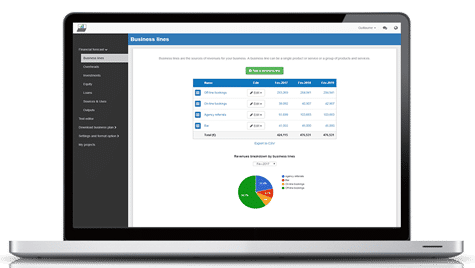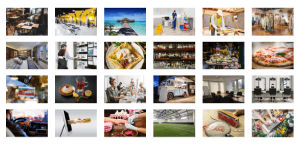How to create a financial forecast for a pizzeria?
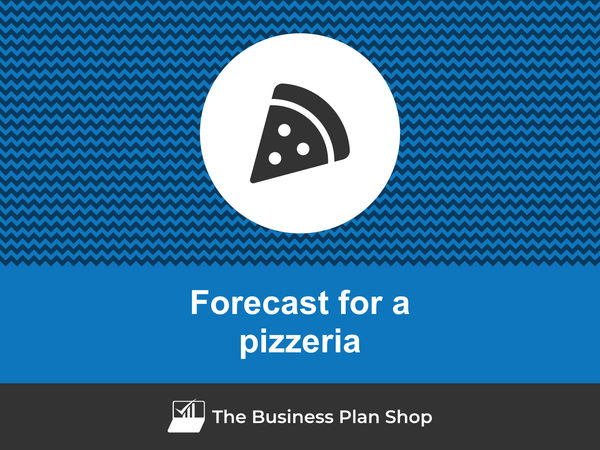
If you are serious about keeping visibility on your future cash flows, then you need to build and maintain a financial forecast for your pizzeria.
Putting together a pizzeria financial forecast may sound complex, but don’t worry, with the right tool, it’s easier than it looks, and The Business Plan Shop is here to guide you.
In this practical guide, we'll cover everything you need to know about building financial projections for your pizzeria.
We will start by looking at why they are key, what information is needed, what a forecast looks like once completed, and what solutions you can use to create yours.
Let's dive in!
Why create and maintain a financial forecast for a pizzeria?
In order to prosper, your business needs to have visibility on what lies ahead and the right financial resources to grow. This is where having a financial forecast for your pizzeria becomes handy.
Creating a pizzeria financial forecast forces you to take stock of where your business stands and where you want it to go.
Once you have clarity on the destination, you will need to draw up a plan to get there and assess what it means in terms of future profitability and cash flows for your pizzeria.
Having this clear plan in place will give you the confidence needed to move forward with your business’s development.
Having an up-to-date financial forecast for a pizzeria is also useful if your trading environment worsens, as the forecast enables you to adjust to your new market conditions and anticipate any potential cash shortfall.
Finally, your pizzeria's financial projections will also help you secure financing, as banks and investors alike will want to see accurate projections before agreeing to finance your business.
Need a solid financial forecast?
The Business Plan Shop does the maths for you. Simply enter your revenues, costs and investments. Click save and our online tool builds a three-way forecast for you instantly.
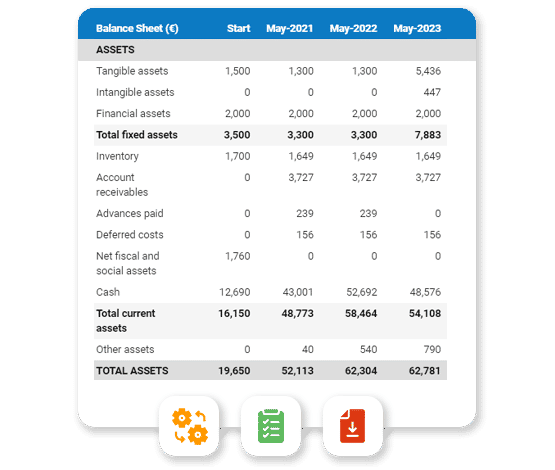
What information is used as input to build a pizzeria financial forecast?
A pizzeria's financial forecast needs to be built on the right foundation: your assumptions.
The data required to create your assumptions will depend on whether you are a new or existing pizzeria.
If you are creating (or updating) the forecast of an existing pizzeria, then your main inputs will be historical accounting data and operating metrics, and your team’s view on what to expect for the next three to five years.
If you are building financial projections for a new pizzeria startup, you will need to rely on market research to form your go-to-market strategy and derive your sales forecast.
For a new venture, you will also need an itemised list of resources needed for the pizzeria to operate, along with a list of equipment required to launch the venture (more on that below).
Now that you understand what is needed, let’s have a look at what elements will make up your pizzeria's financial forecast.
The sales forecast for a pizzeria
From experience, it is usually best to start creating your pizzeria financial forecast by your sales forecast.
To create an accurate sales forecast for your pizzeria, you will have to rely on the data collected in your market research, or if you're running an existing pizzeria, the historical data of the business, to estimate two key variables:
- The average price
- The number of monthly transactions
To get there, you will need to consider the following factors:
- Seasonal demand: As a pizzeria owner, you know that certain times of the year, such as summer and winter holidays, tend to result in higher demand for pizza. This can affect your average price and number of monthly transactions, as you may need to increase prices to meet the higher demand or hire more staff to handle the increase in orders.
- Competition: The presence of other pizzerias in your area can also affect your sales forecast. If there are many competitors, you may need to lower your prices to stay competitive and attract customers. On the other hand, if you are the only pizzeria in the area, you may be able to charge higher prices and expect higher average sales.
- Economic conditions: Economic factors such as inflation, unemployment, and consumer confidence can also affect your pizzeria's sales forecast. During times of economic downturn, people may have less disposable income and be less likely to dine out, resulting in lower sales. Alternatively, during a strong economy, people may be more willing to spend money on dining out, leading to higher sales.
- Menu changes: Introducing new menu items or changing your existing menu can also impact your average price and number of monthly transactions. If the new items are well-received, you may see an increase in sales. However, if the changes are not well-received, you may see a decrease in sales.
- Online ordering: In today's digital age, many customers prefer to order food online rather than in person. The availability of online ordering for your pizzeria and the ease of use of your online ordering system can affect your sales forecast. If your website is user-friendly and offers convenient online ordering, you may see an increase in sales from customers who prefer this method of ordering.
Once you have an idea of what your future sales will look like, it will be time to work on your overhead budget. Let’s see what this entails.
Need inspiration for your business plan?
The Business Plan Shop has dozens of business plan templates that you can use to get a clear idea of what a complete business plan looks like.
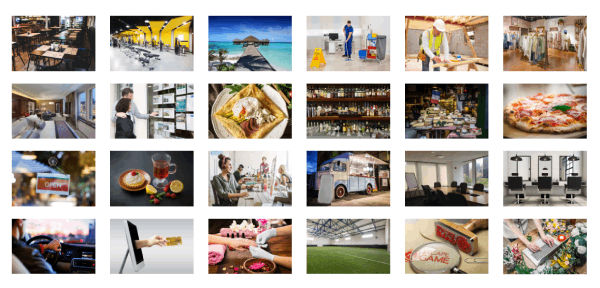
The operating expenses for a pizzeria
The next step is to estimate the expenses needed to run your pizzeria on a day-to-day basis.
These will vary based on the level of sales expected, and the location and size of your business.
But your pizzeria's operating expenses should include the following items at a minimum:
- Staff Costs: This includes the salaries, wages, and benefits for your pizzeria staff, such as pizza chefs, servers, and delivery drivers.
- Food and Ingredient Costs: This covers the cost of purchasing ingredients and supplies for your pizza menu, such as cheese, flour, tomatoes, and toppings.
- Rent or Lease: You may need to pay rent or lease for your pizzeria space, whether it's a standalone restaurant or located in a shopping center.
- Utilities: These are the ongoing expenses for electricity, gas, water, and other utilities needed to keep your pizzeria running.
- Marketing and Advertising: To attract customers, you may need to spend money on marketing and advertising efforts, such as flyers, social media ads, or sponsoring local events.
- Accountancy Fees: You may need to hire an accountant to help with bookkeeping, payroll, and tax preparation for your pizzeria.
- Insurance Costs: It's important to have insurance coverage for your pizzeria, including general liability, property, and worker's compensation insurance.
- Software Licenses: You may need to purchase software licenses for point-of-sale systems, accounting software, or online ordering platforms for your pizzeria.
- Banking Fees: This includes any fees associated with your business bank account, such as monthly maintenance fees or transaction fees.
- Cleaning and Maintenance: Keeping your pizzeria clean and well-maintained is important for customer satisfaction, so you may need to budget for cleaning supplies and maintenance services.
- Packaging and Supplies: If you offer delivery or takeout options, you'll need to purchase packaging materials, such as pizza boxes, bags, and utensils.
- Training and Development: It's important to invest in your staff's training and development to ensure they have the skills and knowledge to provide high-quality service and make delicious pizzas.
- Licenses and Permits: You may need to obtain various licenses and permits to operate your pizzeria, including food service permits, health department permits, and alcohol licenses (if applicable).
- Equipment Maintenance and Repairs: Your pizzeria equipment, such as ovens, refrigerators, and dough mixers, may require regular maintenance or repairs to keep them in good working condition.
- Credit Card Processing Fees: If you accept credit or debit card payments, you'll need to pay processing fees for each transaction.
This list is, of course, not exhaustive, and you'll have to adapt it according to your precise business model and size. A small pizzeria might not have the same level of expenditure as a larger one, for example.
What investments are needed to start or grow a pizzeria?
Your pizzeria financial forecast will also need to include the capital expenditures (aka investments in plain English) and initial working capital items required for the creation or development of your business.
For a pizzeria, these could include:
- Pizza Oven: This is the most essential piece of equipment for a pizzeria. You will need to invest in a high-quality, commercial-grade pizza oven to ensure that your pizzas are cooked to perfection. Depending on the size of your pizzeria, you may need to purchase multiple ovens to keep up with demand.
- Refrigeration Units: In order to store and preserve your ingredients, you will need to invest in refrigeration units. This includes walk-in coolers for storing larger quantities of ingredients, as well as reach-in coolers for easy access to frequently used items.
- Dough Mixer: A dough mixer is a crucial piece of equipment for any pizzeria. It allows you to mix and knead large batches of dough quickly and efficiently, saving you time and labor costs. Look for a mixer with multiple speed settings and a large capacity to meet the demands of your pizzeria.
- Furniture and Decor: Creating a welcoming and comfortable atmosphere for your customers is important for the success of your pizzeria. This may include investing in tables, chairs, lighting, and other decor items. Consider the style and theme of your pizzeria when choosing furnishings.
- Point of Sale System: A modern and efficient point of sale (POS) system is essential for keeping track of sales, inventory, and other important data. It also allows for easy and accurate payment processing. Look for a system that is user-friendly and has features that cater specifically to pizzerias, such as customizable pizza toppings and sizes.
Again, this list will need to be adjusted according to the size and ambitions of your pizzeria.
Need a convincing business plan?
The Business Plan Shop makes it easy to create a financial forecast to assess the potential profitability of your projects, and write a business plan that’ll wow investors.
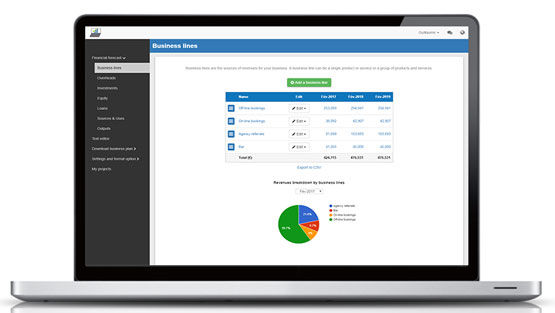
The financing plan of your pizzeria
The next step in the creation of your financial forecast for your pizzeria is to think about how you might finance your business.
You will have to assess how much capital will come from shareholders (equity) and how much can be secured through banks.
Bank loans will have to be modelled so that you can separate the interest expenses from the repayments of principal, and include all this data in your forecast.
Issuing share capital and obtaining a bank loan are two of the most common ways that entrepreneurs finance their businesses.
What tables compose the financial plan for a pizzeria?
Now let's have a look at the main output tables of your pizzeria's financial forecast.
The projected profit & loss statement
The projected profit & loss shows how profitable your pizzeria is likely to be in the years to come.

For your pizzeria to be financially viable, your projected P&L should ideally show:
- Sales growing above inflation (the higher the better)
- Profit margins which are stable or expanding (the higher the better)
- A net profit at the end of each financial year (the higher the better)
This is for established pizzerias, there is some leniency for startups which will have numbers that will look a bit different than existing businesses.
The projected balance sheet
Your pizzeria's projected balance sheet provides a snapshot of your business’s financial position at year-end.
It is composed of three types of elements: assets, liabilities and equity:
- Assets: represent what the business possesses including cash, equipment, and accounts receivable (money owed by clients).
- Liabilities: represent funds advanced to the business by lenders and other creditors. They include accounts payable (money owed to suppliers), taxes payable and loans from banks and financial institutions.
- Equity: is the combination of what has been invested by the business owners and the cumulative profits and losses generated by the business to date (which are called retained earnings). Equity is a proxy for the value of the owner's stake in the business.
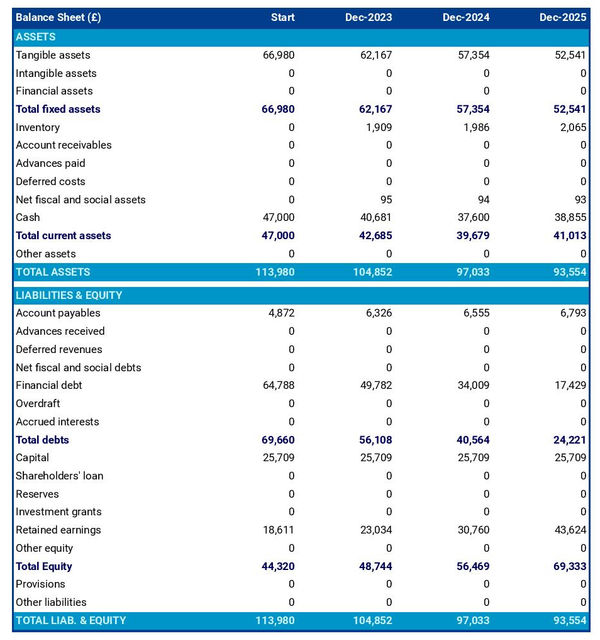
The cash flow projection
The cash flow forecast of your pizzeria will show how much cash the business is expected to generate or consume over the next three to five years.
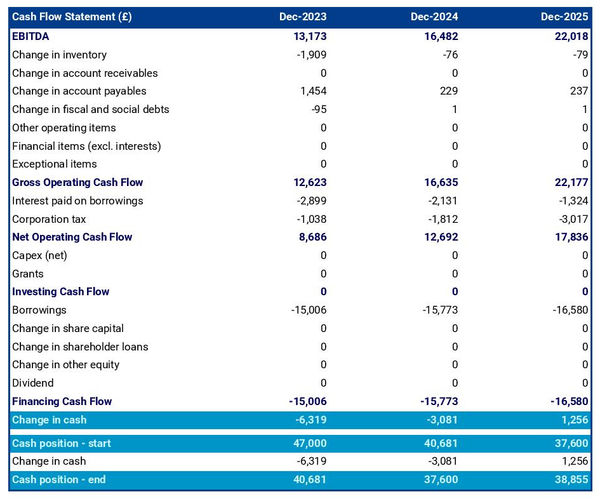
There are multiple ways of presenting a cash flow forecast but from experience, it is better to organise it by nature in order to clearly show these elements:
- Operating cash flow: how much cash is generated by the pizzeria's operations
- Investing cash flow: what is the business investing to expand or maintain its equipment
- Financing cash flow: is the business raising additional funds or repaying financiers (debt repayment, dividends)
Your cash flow forecast is the most important element of your overall financial projection and that’s where you should focus your attention to ensure that your pizzeria is adequately funded.
Note: if you are preparing a financial forecast in order to try to secure funding, you will need to include both a yearly and monthly cash flow forecast in your pizzeria's financial plan.
Need a solid financial forecast?
The Business Plan Shop does the maths for you. Simply enter your revenues, costs and investments. Click save and our online tool builds a three-way forecast for you instantly.

Which tool should you use to create your pizzeria's financial forecast?
Using the right tool or solution will make the creation of your pizzeria's financial forecast much easier than it sounds. Let’s explore the main options.
Using online financial forecasting software to build your pizzeria's projections
The modern and easiest way is to use an online financial forecasting tool such as the one we offer at The Business Plan Shop.
There are several advantages to using specialised software:
- You can easily create your financial forecast by letting the software take care of the financial calculations for you without errors
- You have access to complete financial forecast templates
- You get a complete financial forecast ready to be sent to your bank or investors
- You can easily track your actual financial performance against your financial forecast, and recalibrate your forecast as the year goes by
- You can create scenarios to stress test your forecast's main assumptions
- You can easily update your forecast as time goes by to maintain visibility on future cash flows
- You have a friendly support team on standby to assist you when you are stuck
- It’s cost-efficient and much cheaper than using an accountant or consultant (see below)
If you are interested in this type of solution, you can try our projection software for free by signing up here.
Calling in a financial consultant or chartered accountant
Enlisting the help of a consultant or accountant is also a good way to obtain a professional pizzeria financial forecast.
The downside of this solution is its cost. From experience, obtaining a simple financial forecast over three years (including a balance sheet, income statement, and cash flow statement) is likely to cost a minimum of £700 or $1,000.
The indicative cost above, is for a small business, and a forecast is done as a one-shot exercise. Using a consultant or accountant to track your actuals vs. forecast and to keep your financial projections up to date on a monthly or quarterly basis will cost a lot more.
If you opt for this solution, make sure your accountant has in-depth knowledge of your industry, so that they may challenge your figures and offer insights (as opposed to just taking your assumptions at face value to create the forecast).
Why not use a spreadsheet such as Excel or Google Sheets to build your pizzeria's financial forecast?
You and your financial partners need numbers you can trust. Unless you have studied finance or accounting, creating a trustworthy and error-free pizzeria financial forecast on a spreadsheet is likely to prove challenging.
Financial modelling is very technical by nature and requires a solid grasp of accounting principles to be done without errors. This means that using spreadsheet software like Excel or Google Sheets to create accurate financial forecasts is out of reach for most business owners.
Creating forecasts in Excel is also inefficient nowadays:
- Software has advanced to the point where forecasting can be done much faster and more accurately than manually on a spreadsheet.
- With artificial intelligence, the software is capable of detecting mistakes and helping decision-making.
Spreadsheets are versatile tools but they are not tailor-made for reporting. Importing your pizzeria's accounting data in Excel to track actual vs. forecast is incredibly manual and tedious (and so is keeping forecasts up to date). It is much faster to use dedicated financial planning tools like The Business Plan Shop which are built specially for this.
Need a convincing business plan?
The Business Plan Shop makes it easy to create a financial forecast to assess the potential profitability of your projects, and write a business plan that’ll wow investors.

Use our financial projection templates for inspiration
The Business Plan Shop has dozens of financial forecasting templates available.
Our examples contain both the financial forecast, and a written business plan which presents, in detail, the company, the team, the strategy, and the medium-term objectives.
Whether you are just starting out or already have your own pizzeria, looking at our template is always a good way to get ideas on how to model financial items and what to write when creating a business plan to secure funding.

Takeaways
- A financial projection shows expected growth, profitability, and cash generation for your business over the next three to five years.
- Tracking actuals vs. forecast and keeping your financial forecast up-to-date is the only way to maintain visibility on future cash flows.
- Using financial forecasting software makes it easy to create and maintain up-to-date projections for your pizzeria.
You have reached the end of our guide. We hope you now have a better understanding of how to create a financial forecast for a pizzeria. Don't hesitate to contact our team if you have any questions or want to share your experience building forecasts!
Need inspiration for your business plan?
The Business Plan Shop has dozens of business plan templates that you can use to get a clear idea of what a complete business plan looks like.

Also on The Business Plan Shop
Know someone who runs or wants to start a pizzeria? Share our financial projection guide with them!

